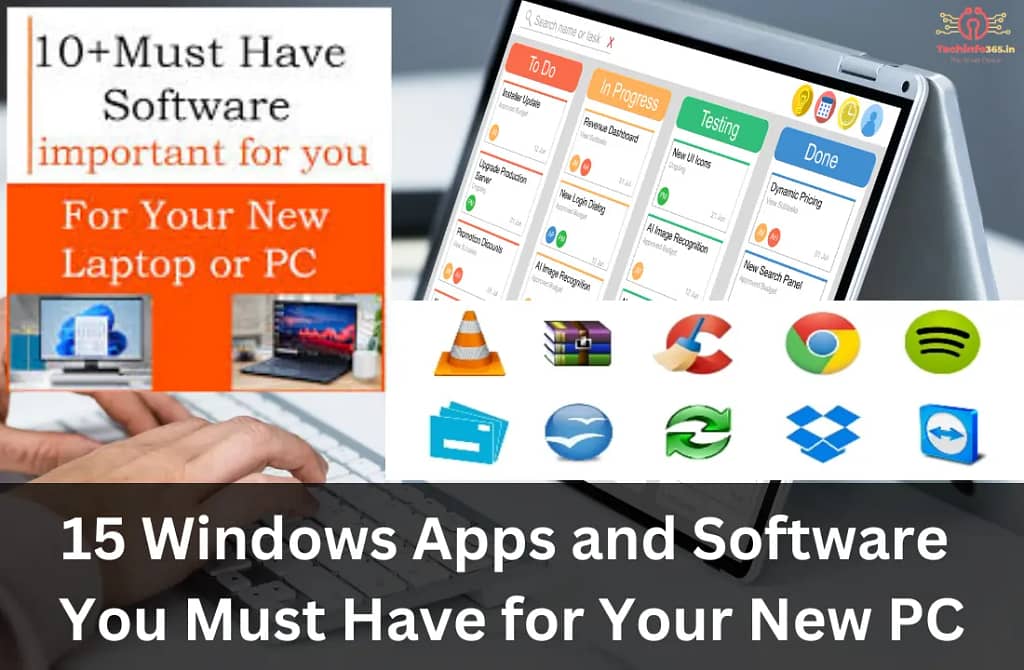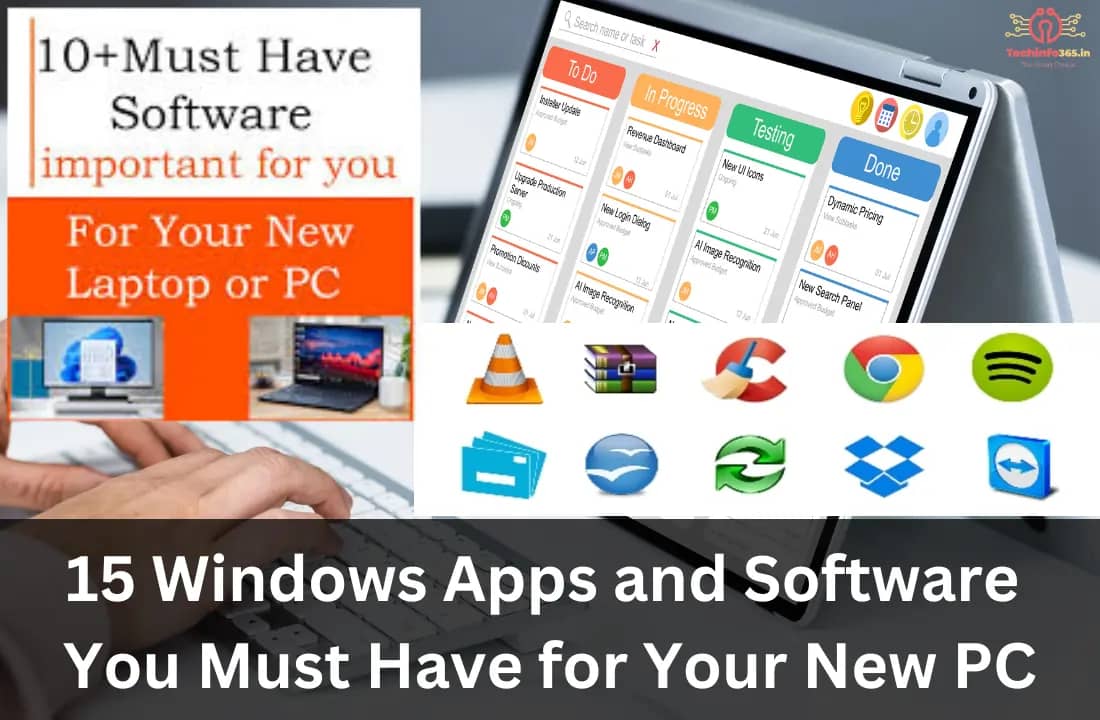Essential,laptop/pc user


Certainly! Here’s a list of essential software for a newly installed Windows system along with brief descriptions of each:
Essential Software Picks for New PC/Laptop Users: Boost Your Productivity and Security!
Here The List Manadatory Softwares Of Every PC/Laptops Users.
- Web Browser (e.g., Google Chrome, Mozilla Firefox, Microsoft Edge)
- Antivirus Software (e.g., Windows Defender, Avast, Bitdefender)
- Office Suite (e.g., Microsoft Office, LibreOffice)
- Media Player (e.g., VLC Media Player, Windows Media Player)
- Compression Software (e.g., 7-Zip, WinRAR)
- PDF Reader (e.g., Adobe Acrobat Reader, SumatraPDF)
- PDF Reader (e.g., Adobe Acrobat Reader, SumatraPDF)
Web Browser
Web Browser (e.g., Google Chrome, Mozilla Firefox, Microsoft Edge)
Essential for accessing websites and online services. Choose one based on your preference for features and performance.
essential-software-every-new-pc-users
1. Mozilla Firefox
– Firefox is a fast, customizable, and privacy-focused web browser.
– It offers various features such as tabbed browsing, built-in privacy protections, and extensive add-on support.
– Firefox is known for its commitment to user privacy and open-source development.
2. Google Chrome
– Chrome is a fast, secure, and widely used web browser developed by Google.
– It features a clean interface, fast performance, and seamless integration with Google services.
– Chrome supports a vast ecosystem of extensions and offers features like cross-device syncing and built-in translation.
3. Microsoft Edge
– Edge is the default web browser for Windows 10 and is available for free download on other platforms.
– It is built on the Chromium open-source project, which ensures compatibility with websites and extensions designed for Chrome.
– Edge emphasizes performance, security, and productivity with features like Collections for organizing web content and built-in tracking prevention.
Antivirus Software
Antivirus Software (e.g., Windows Defender, Avast, AVG)**: Protects your system from malware, viruses, and other security threats
1. Windows Defender (Microsoft Defender Antivirus)
– Windows Defender is Microsoft’s built-in antivirus solution for Windows 10 and later versions.
– It offers real-time protection against viruses, malware, spyware, and other threats.
– Windows Defender integrates seamlessly with Windows Security Center and receives regular updates through Windows Update.
2. Avast Free Antivirus
– Avast Free Antivirus is a popular free antivirus software that offers comprehensive protection against viruses, malware, ransomware, and other online threats.
– It includes features such as real-time protection, Wi-Fi security scanning, browser cleanup, and a password manager.
– Avast Free Antivirus has a user-friendly interface and receives frequent updates to keep up with new threats.
3. AVG Antivirus Free
– AVG Antivirus Free is another widely used free antivirus program that provides basic protection against viruses, malware, and other threats.
– It offers features such as real-time scanning, web protection, email scanning, and a file shredder for secure file deletion.
– AVG Antivirus Free is known for its ease of use and low system resource usage, making it suitable for older computers or systems with limited resources.
Office Suite
Office Suite (e.g., Microsoft Office, LibreOffice)**: Allows you to create documents, spreadsheets, presentations, and more.
- Microsoft Office: One of the most widely used office suites, including applications like Microsoft Word (for word processing), Excel (for spreadsheets), PowerPoint (for presentations), Outlook (for email and scheduling), and more.
- LibreOffice: A free and open-source office suite that offers similar functionality to Microsoft Office, including Writer (word processing), Calc (spreadsheets), Impress (presentations), and others.
Media Player
Media Player (e.g., VLC Media Player, Windows Media Player)
Plays various multimedia formats, including audio and video files. VLC Media Player is highly versatile and supports numerous formats, while Windows Media Player comes pre-installed on Windows but has limited codec support.
1. VLC Media Player
– VLC Media Player is a versatile, free, and open-source multimedia player that supports a wide range of audio and video formats.
– It is known for its ability to play virtually any media file without the need for additional codecs.
– VLC offers advanced features such as customizable playback controls, support for subtitles, audio and video filters, and streaming capabilities.
2. Media Player Classic – Home Cinema (MPC-HC)
– MPC-HC is a lightweight, free, and open-source media player that resembles the classic Windows Media Player but with additional features and improvements.
– It supports a variety of audio and video formats and offers features like customizable playback settings, subtitle support, and minimal resource usage.
– MPC-HC is suitable for users who prefer a simple and efficient media player without unnecessary bloat.
3. PotPlayer
– PotPlayer is a feature-rich multimedia player that offers extensive customization options and support for various audio and video formats.
– It comes with a sleek and modern interface and includes advanced features such as hardware acceleration, 3D playback, scene bookmarking, and skinning support.
– PotPlayer is suitable for users who want a highly customizable media player with advanced playback capabilities.
Compression Software
Compression Software (e.g., 7-Zip, WinRAR)
Allows you to compress and decompress files and folders, making it easier to share and store large amounts of data. 7-Zip is free and open-source, while WinRAR offers additional features but requires a paid license.
1. 7-Zip
– 7-Zip is a free, open-source file archiver and compression utility with a high compression ratio.
– It supports a wide range of compression formats, including 7z, ZIP, TAR, and RAR, and can extract files from most archive formats.
– 7-Zip integrates with Windows Explorer, allowing you to compress and extract files via the context menu.
2. WinRAR
– WinRAR is a powerful compression tool with support for multiple archive formats, including RAR, ZIP, CAB, ARJ, and more.
– It offers features such as high compression ratios, password protection, and the ability to split archives into smaller parts.
– WinRAR provides a user-friendly interface and integrates with Windows Explorer for convenient file management.
3. PeaZip
– PeaZip is a free, open-source file archiver that supports a wide range of compression formats, including 7z, ZIP, TAR, and GZIP.
– It offers advanced features such as encryption, file splitting, and batch compression, making it suitable for both casual and advanced users.
– PeaZip has a customizable interface and supports multiple languages, making it accessible to users worldwide.
PDF Reader
PDF Reader (e.g., Adobe Acrobat Reader, Foxit Reader)**: Opens and views PDF documents
is the standard PDF viewer for viewing, printing, and annotating PDF documents. With its intuitive interface and comprehensive features, it’s the essential tool for working with PDF files.
- Adobe Acrobat Reader: Developed by Adobe, Acrobat Reader is one of the most widely used PDF readers, offering a comprehensive set of features for viewing, printing, and annotating PDF documents.
- SumatraPDF: SumatraPDF is a lightweight and open-source PDF reader known for its fast performance and minimalistic design. It focuses on providing essential PDF viewing functionality without unnecessary features.
- Foxit Reader: Foxit Reader is a feature-rich PDF reader that offers advanced capabilities such as PDF creation, form filling, and document collaboration features.

Wow amazing blog layout How long have you been blogging for you made blogging look easy The overall look of your web site is magnificent as well as the content
I just wanted to say that your article is remarkable. The clarity and depth of your knowledge are truly refreshing. May I subscribe to keep up with your future posts? Keep up the fantastic work!